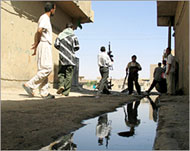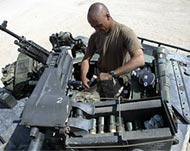Najaf nurses wounds of war
Thirty-eight-year-old Faiza Abd al-Kasim’s head was wrapped in bloody bandages when we were ushered into her crowded hospital ward.

In addition to three other badly wounded patients, dozens of family members were seated in between the beds and all were eager to tell us their accounts of the recent fighting in Najaf.
Faiza’s husband, Kalim, explained to us that his wife had been hit by mortar shrapnel when a shell exploded in their garden during the heavy fighting between Shia militiamen and US troops on 3 June.
The onlookers in the room nodded solemnly as Kalim told us that Faiza, a mother of three young children, was unlikely to make a full recovery due to the extent of the brain damage.
However, the mood in the ward changed dramatically when he stated that the errant mortar shell was fired by the Iraqi resistance.
One man pushed forward to tell me: “Mister, this was done by Americans.” Kalim argued that he had recovered the remnants of a 120mm calibre shell – a weapon the US army does not possess – but his relatives continued shouting for him to be silent.
‘Ongoing crisis’
Regardless of which side is responsible for individual cases of collateral damage, there is no question that the civilians of Najaf have suffered a terrible toll since the fighting erupted on 4 April between the followers of Shia cleric Muqtada al-Sadr and the US forces sent to arrest him.
“All of the shops and markets were closed for two months, up until the [4 June] ceasefire,” explained Dr Al-Tufili, the chief administrator at the Najaf emergency hospital.
 |
|
Residents of Najaf have suffered |
“Most of the casualties that we treated occurred when civilians left their homes to search for food and water, and were shot by mistake.”
Dr Al-Tufili was reluctant to give exact casualty figures, as his hospital also treats al-Sadr’s fighters and, although the ceasefire is holding, such information is still considered to be sensitive military intelligence.
“Let us just say that there have been ‘thousands’ wounded and ‘hundreds’ killed,” said Dr al-Tufili. “With only two small operating rooms available, you can only describe our situation as being an ongoing crisis.”
Fear of capture
With a peacetime capacity of 200 beds, which has been expanded by an additional 50, the Najaf hospital can accommodate only the most severely wounded while the less critical-care patients are treated and released.
“Another reason that many of our patients don’t stay here is that they are afraid the Americans will come here to arrest them,” said Dr Al-Tufili.
“Until now, the US troops have not tried to do this, but we live in fear of such a possibility.”
Less than a kilometre from Najaf’s small emergency hospital is a much larger and better equipped training hospital.
On 5 April, after reportedly taking hostile fire from Muqtada’s militia inside the premises, US troops occupied the teaching hospital and evacuated all the Iraqi patients to the smaller emergency facility. Despite the ceasefire, the teaching hospital remains empty except for a detachment of coalition forces from El Salvador.
“For the sake of the suffering citizens of Najaf, the Americans must give us back the hospital,” said Dr Al-Tufili. “How can soldiers evict wounded patients and claim that this is freedom?”
The US view
Two kilometres away, at the front gate of the main US military base in Najaf, Staff Sergeant Wolfine has a different opinion about how the conflict in Iraq should be conducted.
|
“Here in Najaf, Muqtada’s fighters are fanatical – they come straight at us and are not afraid to die” US Army Staff Sergeant Wolfine |
“This ain’t no way to fight a war. Not when the Pentagon sets up ‘zones of exclusion’ and ‘safe areas’ where we can’t conduct operations,” said the Michigan-born 12-year veteran. “The bad guys have long since figured out where to go and hide.”
Unlike the Iraqi doctors, the US troops in Najaf have no qualms about discussing the body count from the recent clashes. “We’ve killed over three hundred,” said one young Specialist who gave only Gary as his name. “That’s an average of five a day.”
Staff Sergeant Wolfine, 33, was more analytical about the situation. “This is an entirely different type of fighter than the Sunni militia that we fought in Falluja and Ramadi. They would use remotely detonated explosives and fire-and-dash ambushes.
“It was like fighting ghosts – there was nothing to shoot back at,” Wolfine said. “But here in Najaf, Muqtada’s fighters are fanatical – they come straight at us and are not afraid to die.”
Al-Sadr loyalists
Shaikh Anwar is a 24-year-old religious student and supporter of al-Sadr. Although based in Baghdad, he has made numerous trips into Najaf during the past two months of heavy fighting in order to deliver medicine and food.
“The Americans do not yet understand the loyalty of Muqtada’s followers,” he explained.
“When the US first launched their attacks against Najaf, [Muqtada] called upon his people in nearby Karbala to join the fight. Within hours, Shia followers were turning themselves into human suicide bombs and attacking US tanks.”
Although the ceasefire remains in place, Shaikh Anwar believes there cannot be a lasting peace as long as the US insists on the arrest of Muqtada.
“If he is ever captured or killed, then all of Iraq will explode in violence.”
No return
The US soldiers in Najaf have a far different opinion about the current ceasefire. Standing in a concrete bunker, staring out over a sandbag parapet with hundreds of spent machine-gun casings littering the ground at his feet, Specialist Gary says: “It’s too quiet. And what I don’t like about this is that it means [Muqtada’s fighters] have time to re-arm and re-organise.”
 |
|
Constant demand has worn down |
However, such an operational reprieve is something the US occupation forces have been singlularly unable to attain.
“Our unit was all packed up, the vehicles and weapons were stowed, even our extra uniforms were turned in, and we were sitting in Kuwait waiting to fly home when all hell broke loose and we were ordered to deploy back into Iraq,” said Staff Sergeant Wolfine.
As a senior non-commissioned officer with the 2nd Armoured Cavalry Regiment (2ACR), his unit was among the 30,000 US personnel who had their tours of duty extended by at least three months when the insurgency escalated in April.
“I was due to go home and get married on 12 June, so I was pretty pissed personally. But as a senior leader, I had to tell the young soldiers to toughen up and get on with it. You can imagine that morale was in the toilet.”
Overhearing our conversation, another soldier in 2ACR piped up: “Hey, I’m from Texas, and let me tell you that, right now, I hate Bush. Not for getting us into Iraq in the first place – I’m not even going to go there – but now he can’t figure out a way to get us home except in a body bag.”
Back-up problems
In the 14 months since they have been deployed into Iraq, the troops of 2ACR have rotated through many of the resistance hotspots – such as Falluja and Ramadi – and participated in major offensive operations along the Syrian border.
“What really sucks is that until we got recalled to Najaf, this was the only combat unit in the American army that had not suffered any KIAs [killed in action],” said Wolfine.
“We’d sent home a lot of guys that got wounded – but now that we’re sending home bodies. It changes things.”
When asked how many KIAs the 2ACR has suffered, the veteran soldier smiled and said: “Whatever number the Pentagon has officially admitted to.”
Battle toll
Since 14 April, when the US first announced its intention to arrest al-Sadr, his followers in Najaf and other major cities have been in open revolt.
It is estimated that more than 300 Shia fighters have been killed in Najaf alone and the occupation forces have suffered a similar number in incidents throughout all of Iraq in the past two months.
|
“It’s too quiet. And what I don’t like about this is that it means [Muqtada’s fighters] have time to re-arm and re-organise” US Army Specialist Gary |
However, the ongoing Iraqi resistance has taken its toll on more than just the morale and numbers of the US troops. The constant operational demand has worn down their vehicles and equipment.
Battlefield modifications, such as the welding of additional armour plates to combat vehicles, have provided a stop-gap solution, but the rate at which US Hummers have been destroyed in attacks by the resistance is worryingly high.
New replacement vehicles are slow in arriving. Pointing at his battered and scarred vehicle, Wolfine says: “This baby was built in 1985 – one of the original batch of Hummers purchased by the army. This is due for the scrap heap and we are long overdue to receive some of the newer up-armoured vehicles.”